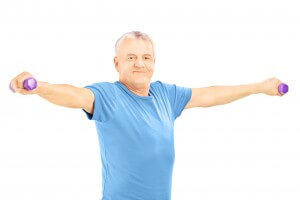Osteoporosis is a disease of the bones, which occurs when you lose too much bone, make too little bone, or both. Osteoporosis literally means “porous bone”. The holes and spaces that are found within bone are much larger in osteoporotic bone than in normal bone, making it less dense and weaker. This causes the bone to become more likely to break either spontaneously or in the event of a fall.
About 52 million Americans suffer from osteoporosis and low bone mass, and studies suggest that one in two women and one in four men age 50 and older will break a bone due to osteoporosis. 20% of seniors who break a hip die within a year either from problems related to the broken bone itself or from the surgery to repair it. Many who survive never return to their prior level of function and need long-term nursing home care. Osteoporosis is a serious and unfortunately common disease; in fact, a woman’s risk of breaking a hip due to osteoporosis equals her risk of contracting breast, ovarian, and uterine cancer combined!
There are a variety of risk factors for osteoporosis, some of which we can’t control. These include increased age (over 50), being female, menopause, family history, and low body weight (small and thin people are at higher risk). There are also risk factors that we CAN control, so if you fit into some of the risk factors above, changing your lifestyle can help! Some things you can do to help prevent osteoporosis include getting more calcium and vitamin D, eating more fruits and vegetables, cutting down on sodium and caffeine, increasing exercise (especially weight training), cutting down on alcohol, and stopping smoking.
MTI Physical Therapists are trained to work with patients on an individualized exercise program to help with building and maintaining bone density. Bone mass peaks in both men and women at about age 30-35, with teenagers and young adults forming more bone than they lose, and older adults slowly losing more than they form. Therefore exercising early in life is important, we want to reach our thirties with high bone mass so that even if we lose a little as we age, we still have bone to spare. It’s never too late though, and beginning an exercise regime later in life can still slow down the rate of bone loss if it has already begun. Since low body weight is a risk factor for osteoporosis, exercises should not focus purely on cardiovascular exercise working toward fat loss. Instead, exercises should focus on building muscle through techniques such as weight lifting for example, which increases load on bones stimulating bone growth. Exercising with increased weight, such as walking with a weighted vest or backpack, may be helpful as increased gravity help build bones.
Balance training is also important, as falls in people with osteoporosis are much more likely to lead to fracture and serious long-term health deficits than in falls among people with strong, healthy bones. Ideally, doing weight bearing exercise 30 minutes per day, lifting weights 2-3 days per week, and working on balance and posture a little every day is a great exercise prescription to build or maintain healthy bones.
For more specific evaluation and treatment, contact one of our MTI clinics to schedule an appointment, we’d love to help!
Sarah Olson, PT, MSPT, OCS, FAAOMPT
Physical Therapist
MTI Physical Therapy


